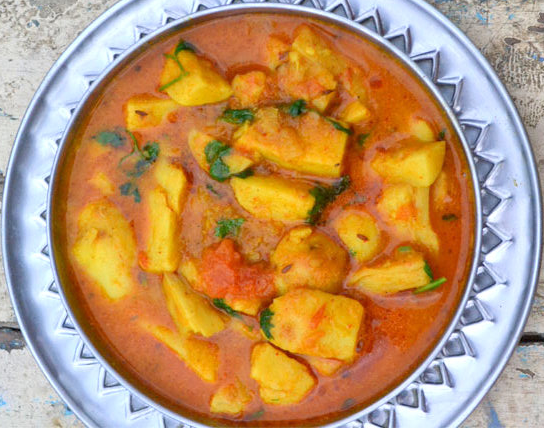Mama’s Punjabi Recipes: Arbi te Wadi di Turri (EDDOE ROOT & LENTIL DUMPLING CURRY)
 This Punjabi recipe incorporates a special favorite ingredient – wadiyyan (sundried lentil dumplings) – with a vegetable that is seasonal but not often used – arbi (eddoe root). Made with a medium thick sauce, and eaten with hot rotis, the results are delicious! So, for those looking for an unusual recipe, below is a reprint of Mama’s Arbi te Wadi di Turri recipe, with some additional comments and directions.
This Punjabi recipe incorporates a special favorite ingredient – wadiyyan (sundried lentil dumplings) – with a vegetable that is seasonal but not often used – arbi (eddoe root). Made with a medium thick sauce, and eaten with hot rotis, the results are delicious! So, for those looking for an unusual recipe, below is a reprint of Mama’s Arbi te Wadi di Turri recipe, with some additional comments and directions.
Punjabis eat the root vegetable arbi (eddoe root) in several ways but when made in a curry it gives competition to the aloo wadiyan curry dish that it resembles, but the taste is much better as the arbi is softer on the palette and soaks up the curry flavor well.
Arbi (eddoe root) is closely related to the taro root but is smaller and has an acrid taste that requires careful cooking. It grows best in rich soil with good drainage but can also be grown in poorer soils and drier climates than the taro root. Eddoe originated in India and Malaysia, and from China and Japan it migrated to the West Indies and the New World.
Among the benefits of arbi are that it reduces fatigue, aids in digestion, controls hypertension, has a low glycemic index making it good for diabetics, has amino acid and Omega-3 oils, builds immunity and slows the aging process. Arbi is high in carbohydrates, the vitamins E and pyridoxine, and potassium and copper.
In the US, you usually find two types of arbis: the larger Chinese or Japanese type which are more fibrous and have a flatter taste than the Indian variety, which are smaller and softer. For best results, choose the medium sized roots.
Some recipes like arbi chaat require that the arbi be steamed or lightly boiled and then the hairy exterior skin can be pulled off. For this recipe, the arbi must be scrapped with a knife as the skin is thin and soft.
This dish requires wadiyan (sun dried lentil dumpling) and though I prefer the Amritsari variety, any large ones that you can find will do. Just remember to brown the wadi so that the wadi will taste cooked otherwise it will give a raw lentil taste.
Ingredients:
• 1 kg arbi (small to medium eddoe root)
• 1 large size Amritsari wadi (sun dried lentil dumpling)
• 2 tbsp tael (vegetable or olive oil)
• 2 cups pani (water)
• 1 large pyaaz (onion) – peeled and chopped
• 2 cloves of lasan (garlic) – peeled and chopped
• 1 medium adrak (ginger) – peeled and chopped
• 1 small tamater (tomato) or 1 tsp tomato paste
• Spices (to taste): namak (salt), mirch (red pepper), dhania (ground coriander), garam masala
Directions:
1. Peel the arbi then coat it with salt and let it sit for 30 minutes. Then wash the arbi well and pat dry with a soft cloth.
2. Cut the arbi into half-inch pieces.
3. In a kadai (wok) or skillet, heat the oil, throw in the wadi and brown it on all sides. When lightly brown, take out and keep to the side.
4. In the remaining oil, throw in the onions, ginger and garlic and brown them while stirring. Turn the heat down to extreme low so as not to burn the spices and stir to mix thoroughly.
5. Throw in the cut arbi into the spices and mix to coat. Add the water and cover and cook for 10 minutes. When the water starts to boil, add the wadi and cover and reduce the heat to low and let cook for 10 minutes. In a little while, the wadi will swell up and take on the flavor of the curry.
6. Check to see if the arbi is cooked and soft but firm to the touch: if it gets too soft it will taste mushy.
7. Sprinkle with garam masala and coriander before serving.
MAMA’S TIP OF THE WEEK: IT’S HALLOWEEN SEASON, SO CLEAN AND DRY PUMPKIN SEEDS TO NIBBLE LATER!
In North India, we call pumpkin’s petha and we make a delicious halwa (pudding) from it, or a mashed, spicy sabzi (sautéed vegetable dish). Agra, the city of the Taj Mahal, is famous for its petha sweets which is actually crystalized pumpkin. So with all these uses for petha, the one thing that is left over are the seeds which can be eaten.
My mother, biji, used to wash, clean all types of seeds of fruits – cantaloupes, apricots, pumpkins to name a few – and then dry them in the sunshine for a few days. We would then while away the hours chatting and cracking open and eating the seeds! In the US, with Halloween just around the corner, try collecting the seeds and cleaning and drying them. You can even dry roast them in the oven or in a skillet. Then pop them open and chat awhile with friends!

Shakuntla Malhotra is a skilled cook of Punjabi dishes made in the old-fashioned style that she learnt as a young woman in her ancestral home in Lyallpur, India (since renamed Faisalabad) before it became part of Pakistan after the Partition in 1947. People have often admired her cooking for its simplicity and taste that comes with each mouthful. Even in her late-eighties, she continues to cook daily and agreed to share her delectable Punjabi recipes for future generations.
